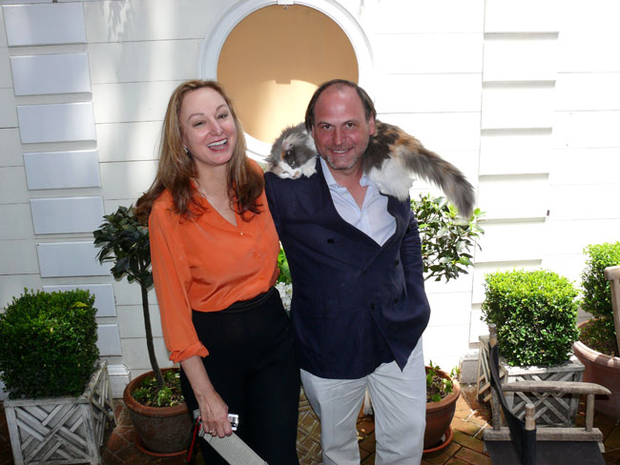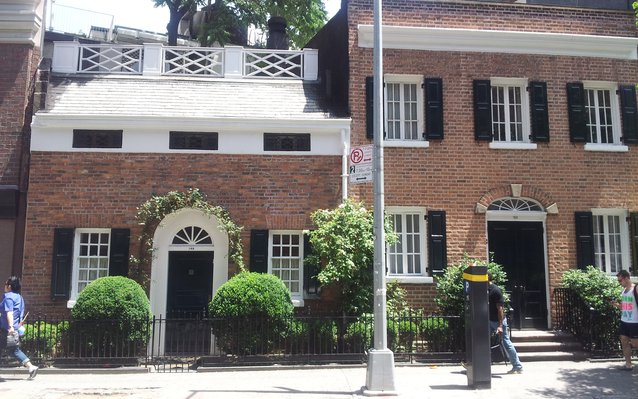New York Social Diary House Feature

NEW YORK SOCIAL DIARY
HOUSE August 17, 2007
By Sian Ballen, Lesley Hauge and Jeff Hirsch
Anne Fairfax and Richard Sammons live in a little house in the Village that once belonged to Armand Hammer, the flamboyant (and highly controversial) industrialist and art collector. There can’t be a house anywhere that has had two such contrasting sets of owners. Where Hammer’s taste ran to leopard prints and gaudiness, theirs is an essay in calm, restraint, and the harmony of a circle, the motif upon which the interior renovation was based. They are one of those rare things, a married couple that works together, each having carved out their respective roles.
Anne, in addition to being a very good architect, seems to also have a talent for diplomacy, managing people and situations before anything can escalate into trouble. Richard is passionate about the traditional architecture that has made its name and, in addition to his day-to-day work, teaches (including a stint at the Prince of Wales’s Institute of Architecture) and curates exhibitions on classical architecture. They obviously work pretty much all the time and have an extraordinarily star-studded clientele, but they were hosting their ten-year-old nephew for the summer (they do not have children themselves), an experience that had re-shaped their world, if only temporarily.
Who did you say had been living here all these years?
Richard: Armand Hammer. This was his little pad in the village. He loved jazz and there was a famous jazz joint on the corner here ... what was it called?
Anne: High Society. There was a big bed right in front of the fireplace and in his memoir he talks about how the Swinging Sixties had nothing on the Swinging Twenties. So I guess he got a lot of action. And then when he got married, his wife made it a real house.
Richard: Ish. It always looked terrible. This side looked like Heidi had decorated it. And he had considerably bad taste. We called this the ‘Tyrolean Loveshack’, over here. And that was ‘Mayfair in Manhattan’ on the other side.
It’s a minefield, the question of good and bad taste. I was interested in something on your website where you said that proportion is a specific design tool but many architects only have a vague, intuitive notion of it.
Richard: Every part has a mathematical or a geometric part to everything else ... that’s not taught in school anywhere. I taught the only university course ordered for it. I started teaching the proportion course at Pratt, and then at the Prince of Wales’s Institute.
Why is it not taught? Is it too boring?
Anne: They don’t know enough about it.
Richard: You’d be surprised ... there was sort of a vein, and it comes from the romantic genius kind of thing, that any real information is somehow going to pollute the native genius ... that you’re going to squash out a budding Frank Lloyd Wright who was going to spring from nowhere. Of course, Frank Lloyd Wright didn’t spring from anywhere anyway.
He had a fairly somewhat Beaux-Arts education ... what proportion really does, it’s nothing to do with necessarily beauty or pace or anything like that, but it sets up an expectation, which is then reinforced, and that gives an orderly appearance to the whole. A building is put together with all kinds of very violent and diverse pieces ... they have to come together and seem as if they are one whole thing.
Some of the houses featured on your website are just so huge. Why do people need houses that are that big?
Richard: We don’t really understand because actually, we live in a little house. There’s a certain phenomenon. First of all, there’s just the guy who wants the big house because ... you know.
Anne: Pride of ownership. It’s just pride of ownership. But what does that mean?
Anne: We had a client actually say [‘pride of ownership’] to us. It’s just the ability to look at the grounds ... maybe it’s Beverly Hillbilly’s syndrome. It’s being driven up not by the women but by the men.
Richard: It’s always by the men.
Anne: The women have to manage these houses that are like hotels, sometimes even larger.
It used to be that in previous centuries when the wealthy built these enormous houses, there wasn’t that much outside, there weren’t restaurants in the same way or the array of other entertainments that now exist. Everything took place in their little kingdoms. But now you don’t need that.
Anne: You know what’s motivating these people? It’s really bizarre: children. They want to be able to keep their children at home, under their supervision as long as possible ... so the women are saying ‘I want a hangout place for my teenagers so they won’t go to somebody else’s house.’
Richard: There is that, and there is another thing, another syndrome. If you’re really famous and you’re really wealthy, you just can’t go to the movie theater and watch a movie, you can’t go to a restaurant necessarily. So it is a refuge and a little kingdom. And they run like little hotels because what they do is invite other people who can’t go anywhere.
Anne: They might even be afraid that their children may be kidnapped.
Richard: We deal with that level but we also deal with very humble things. If you look through our book [The Architecture of Fairfax and Sammons], you’ll actually see that most of the houses are relatively small.
Yeah, I was looking at one in Bedford, actually, it is Steve Brill’s house, and what struck me about it was that although it was timbered and made with old stone, and therefore was very English-looking, I could tell it was American. What is that?
Richard: That’s a very interesting thing. That is a phenomenon that, actually I want to write an article on it, because I don’t care how perfect you think you’re doing a revival style, it looks American. It has to do with very subtle clues about your house relating to the grounds, European houses don’t have bushes in front of the house for one thing ... if it’s a Continental style, those are the most glaringly not what they are. We share our building practices with the Dutch and the English ... we have sash windows, they have casement windows ... all these clues. How big is the baseboard? Do they have baseboards? Because Italian houses don’t.
What about people looking at your work and then saying that it’s not original, that it’s like reproduction furniture?
Richard: I like reproduction furniture if it’s well done. Originality is about as unimportant as it gets. You know what they say about Frank Lloyd Wright, it was about disguising your sources.
Yeah, stealing well. So what do you do when you switch o from architecture?
Anne: Travel. We’re going to Rumania this year.
Richard: We also like to sail.
So, architects can be quite bossy and sailing people are very bossy ... who is more bossy?
[They laugh]
Richard: I think I should probably be more bossy.
SEE THE WORK


